Effects of Plastic Mulch on Soil Heat Flux and Energy Balance in a Cotton Field in Northwest China
Abstract
:1. Introduction
2. Methods and Materials
2.1. Experimental Site and Data Records
2.2. Methods
2.2.1. Surface Soil Heat Flux
2.2.2. Net Radiation
2.2.3. Air Heat Storage
2.2.4. Atmospheric Moisture Change
3. Results and Discussions
3.1. The Effect of Mulch on Soil Temperature and Energy Fluxes
3.2. The Effect of Mulch on Surface Soil Heat Flux
3.2.1. Damped Diurnal Variation of Surface Soil Heat Flux beneath Mulch
3.2.2. Similar Daily Variation of G0
3.3. The Effect of Mulch on Energy Balance
3.3.1. Smaller Net Radiation beneath Mulch
3.3.2. Energy Balance in Mulched and Non-Mulched Soil
4. Conclusions
Acknowledgments
Author Contributions
Conflicts of Interest
Abbreviations
| Rn | net radiation for bare soil (non-mulched) |
| R′n | net radiation for soil beneath mulch |
| G0 | surface soil heat flux |
| LE | latent heat flux |
| L | latent heat of vaporization |
| H | sensible heat flux |
| ρscs | soil volumetric heat capacity |
| ρsolidcsolid | volumetric heat capacity of the soil solids |
| ρwcw | volumetric heat capacity of liquid water |
| ρaca | air volumetric heat capacity |
| θsat | soil porosity |
| θ | soil water content |
| T (z,t) | soil temperature at depth z and time t |
| T (z0) | soil temperature at surface |
| Ts | soil temperature at surface, same as T (z0) |
| T′s | surface soil temperature beneath the mulch |
| Tm | mulch temperature |
| Ta | air temperature |
| S | solar radiation |
upward long-wave radiation flux | |
downward long-wave radiation flux | |
| εs | land surface emissivity |
| εm | mulch emissivity |
| σ | Stefan–Boltzmann constant |
| rs | surface soil reflectivity |
| τm1 | transmittance of mulch for solar radiation |
| τm2 | transmittance of mulch for thermal radiation |
| q | moist air density |
| h | the height of the EC |
| Sc | canopy heat storage in the biomass |
| Sp | photosynthesis flux |
| Sa | air storage |
| Sq | atmospheric moisture change |
| Sd | canopy dew enthalpy change |
References
- Baldocchi, D.D.; Vogel, C.A.; Hall, B. Seasonal variation of carbon dioxide exchange rates above and below a boreal jack pine forest. Agric. For. Meteorol. 1997, 83, 147–170. [Google Scholar] [CrossRef]
- Li, N.; Jiang, L. Temporal variations in the surface soil heat flux over maize and grass surfaces in Northwest China. Soil Sci. Soc. Am. J. 2015, 79, 1084–1093. [Google Scholar] [CrossRef]
- Zuo, J.; Wang, J.; Huang, J.; Li, W.; Wang, G.; Ren, H. Estimation of ground heat flux and its impact on the surface energy budget for a semi-arid grassland. Sci. Cold Arid. Reg. 2011, 3, 41–50. [Google Scholar]
- Li, N.; Jia, L.; Lu, J. An improved algorithm to estimate the surface soil heat flux over a heterogeneous surface: A case study in the heihe river basin. Sci. China Earth Sci. 2015, 58, 1169–1181. [Google Scholar] [CrossRef]
- Katul, G.G.; Oren, R.; Manzoni, S.; Higgins, C.; Parlange, M.B. Evapotranspiration: A process driving mass transport and energy exchange in the soil-plant-atmosphere-climate system. Rev. Geophys. 2012, 50. [Google Scholar] [CrossRef]
- Allen, R.G.; Tasumi, M.; Trezza, R. Satellite-based energy balance for mapping evapotranspiration with internalized calibration (metric)—model. J. Irrig. Drain. Eng. 2007, 133, 380–394. [Google Scholar] [CrossRef]
- Bastiaanssen, W.; Menenti, M.; Feddes, R.; Holtslag, A. A remote sensing surface energy balance algorithm for land (Sebal). 1. Formulation. J. Hydrol. 1998, 212, 198–212. [Google Scholar] [CrossRef]
- Idso, S.B.; Aase, J.K.; Jackson, R.D. Net radiation—Soil heat flux relations as influenced by soil water content variations. Bound.-Layer Meteorol. 1975, 9, 113–122. [Google Scholar] [CrossRef]
- Clothier, B.E.; Clawson, K.L.; Pinter, P.J., Jr.; Moran, M.S.; Reginato, R.J.; Jackson, R.D. Estimation of soil heat flux from net radiation during the growth of alfalfa. Agric. For. Meteorol. 1986, 37, 319–329. [Google Scholar] [CrossRef]
- Kustas, W.P.; Daughtry, C.S.T. Estimation of the soil heat flux/net radiation ratio from spectral data. Agric. For. Meteorol. 1990, 49, 205–223. [Google Scholar] [CrossRef]
- Kustas, W.P.; Daughtry, C.S.T.; Van Oevelen, P.J. Analytical treatment of the relationships between soil heat flux/net radiation ratio and vegetation indices. Remote Sens. Environ. 1993, 46, 319–330. [Google Scholar] [CrossRef]
- Gao, Z.Q. Determination of soil heat flux in a tibetan short-grass prairie. Bound.-Layer Meteorol. 2005, 114, 165–178. [Google Scholar] [CrossRef]
- Gentine, P.; Entekhabi, D.; Heusinkveld, B. Systematic errors in ground heat flux estimation and their correction. Water Resour. Res. 2012, 48. [Google Scholar] [CrossRef]
- Cammalleri, C.; La Loggia, G.; Maltese, A. Critical analysis of empirical ground heat flux equations on a cereal field using micrometeorological data. Proc. SPIE 7472 2009. [Google Scholar] [CrossRef]
- Liebethal, C.; Huwe, B.; Foken, T. Sensitivity analysis for two ground heat flux calculation approaches. Agric. For. Meteorol. 2005, 132, 253–262. [Google Scholar] [CrossRef]
- Stull, R.B. Boundary layer clouds. In An Introduction to Boundary Layer Meteorology; Stull, R.B., Ed.; Springer Netherlands: Dordrecht, The Netherlands, 1988; pp. 545–585. [Google Scholar]
- Sridhar, V. Tracking the influence of irrigation on land surface fluxes and boundary layer climatology. J. Contemp. Water Res. Educ. 2013, 152, 79–93. [Google Scholar] [CrossRef]
- Case, J.L.; Crosson, W.L.; Kumar, S.V.; Lapenta, W.M.; Peters-Lidard, C.D. Impacts of high-resolution land surface initialization on regional sensible weather forecasts from the WRF model. J. Hydrometeorol. 2008, 9, 1249–1266. [Google Scholar] [CrossRef]
- Dirmeyer, P.A.; Koster, R.D.; Guo, Z. Do global models properly represent the feedback between land and atmosphere? J. Hydrometeorol. 2006, 7, 1177–1198. [Google Scholar] [CrossRef]
- Kala, J.; Lyons, T.; Nair, U. Numerical simulations of the impacts of land-cover change on cold fronts in South-West Western Australia. Bound.-Layer Meteorol. 2011, 138, 121–138. [Google Scholar] [CrossRef]
- Fu, C. Potential impacts of human-induced land cover change on east Asia monsoon. Glob. Planet. Chang. 2003, 37, 219–229. [Google Scholar] [CrossRef]
- Pielke, R.A. Land use and climate change. Science 2005, 310, 1625–1626. [Google Scholar] [CrossRef] [PubMed]
- Wang, R.; Kang, Y.; Wan, S.; Hu, W.; Liu, S.; Liu, S. Salt distribution and the growth of cotton under different drip irrigation regimes in a saline area. Agric. Water Manag. 2011, 100, 58–69. [Google Scholar] [CrossRef]
- Zhang, Z.; Tian, F.; Hu, H.; Yang, P. A comparison of methods for determining field evapotranspiration: Photosynthesis system, sap flow, and eddy covariance. Hydrol. Earth Syst. Sci. 2014, 18, 1053–1072. [Google Scholar] [CrossRef]
- Katan, J. Solar heating (solarization) of soil for control of soilborne pests. Annu. Rev. Phytopathol. 1981, 19, 211–236. [Google Scholar] [CrossRef]
- Bonachela, S.; Orgaz, F.; Villalobos, F.J.; Fereres, E. Soil evaporation from drip-irrigated olive orchards. Irrig. Sci. 2001, 20, 65–71. [Google Scholar] [CrossRef]
- Hou, X.-Y.; Wang, F.-X.; Han, J.-J.; Kang, S.-Z.; Feng, S.-Y. Duration of plastic mulch for potato growth under drip irrigation in an arid region of Northwest china. Agric. For. Meteorol. 2010, 150, 115–121. [Google Scholar] [CrossRef]
- Li, S.; Kang, S.; Li, F.; Zhang, L. Evapotranspiration and crop coefficient of spring maize with plastic mulch using eddy covariance in Northwest china. Agric. Water Manag. 2008, 95, 1214–1222. [Google Scholar] [CrossRef]
- Ramakrishna, A.; Tam, H.M.; Wani, S.P.; Long, T.D. Effect of mulch on soil temperature, moisture, weed infestation and yield of groundnut in Northern Vietnam. Field Crops Res. 2006, 95, 115–125. [Google Scholar] [CrossRef]
- Zhang, Z.; Tian, F.; Zhong, R.; Hu, H. Spatial and temporal pattern of soil temperature in cotton field under mulched drip irrigation condition in Xinjiang. Trans. CSAE 2011, 27, 44–51. [Google Scholar]
- Zhang, Z.; Hu, H.; Tian, F.; Hu, H.; Yao, X.; Zhong, R. Soil salt distribution under mulched drip irrigation in an arid area of Northwestern China. J. Arid Environ. 2014, 104, 23–33. [Google Scholar] [CrossRef]
- Hu, H.; Tian, F.; Hu, H. Soil particle size distribution and its relationship with soil water and salt under mulched drip irrigation in Xinjiang of China. Sci. China: Technol. Sci. 2011, 54, 1568–1574. [Google Scholar] [CrossRef]
- Heusinkveld, B.G.; Jacobs, A.F.G.; Holtslag, A.A.M.; Berkowicz, S.M. Surface energy balance closure in an arid region: Role of soil heat flux. Agric. For. Meteorol. 2004, 122, 21–37. [Google Scholar] [CrossRef]
- Meyers, T.P.; Hollinger, S.E. An assessment of storage terms in the surface energy balance of maize and soybean. Agric. For. Meteorol. 2004, 125, 105–115. [Google Scholar] [CrossRef]
- Jacobs, A.G.; Heusinkveld, B.; Holtslag, A.M. Towards closing the surface energy budget of a mid-latitude grassland. Bound.-Layer Meteorol. 2008, 126, 125–136. [Google Scholar] [CrossRef]
- Yang, K.; Wang, J. A temperature prediction-correction method for estimating surface soil heat flux from soil temperature and moisture data. Sci. China Ser. D-Earth Sci. 2008, 51, 721–729. [Google Scholar] [CrossRef]
- Tarara, J.M. Microclimate modification with plastic mulch. HortScience 2000, 35, 169–180. [Google Scholar]
- Xu, Z.; Liu, S.; Xu, T.; Ding, C. The observation and calculation method of soil heat flux and its impact on the energy balance closure. Adv. Earth Sci. 2013, 28, 875–889. [Google Scholar]
- Liakatas, A.; Clark, J.; Monteith, J. Measurements of the heat balance under plastic mulches. Part I. Radiation balance and soil heat flux. Agric. For. Meteorol. 1986, 36, 227–239. [Google Scholar] [CrossRef]
- Chung, S.O.; Horton, R. Soil heat and water flow with a partial surface mulch. Water Resour. Res. 1987, 23, 2175–2186. [Google Scholar] [CrossRef]
- Hares, M.A.; Novak, M.D. Simulation of surface energy balance and soil temperature under strip tillage: II. Field test. Soil Sci. Soc. Am. J. 1992, 56, 29–36. [Google Scholar] [CrossRef]
- Wilson, K.; Goldstein, A.; Falge, E.; Aubinet, M.; Baldocchi, D.; Berbigier, P.; Bernhofer, C.; Ceulemans, R.; Dolman, H.; Field, C.; et al. Energy balance closure at fluxnet sites. Agric. For. Meteorol. 2002, 113, 223–243. [Google Scholar] [CrossRef]
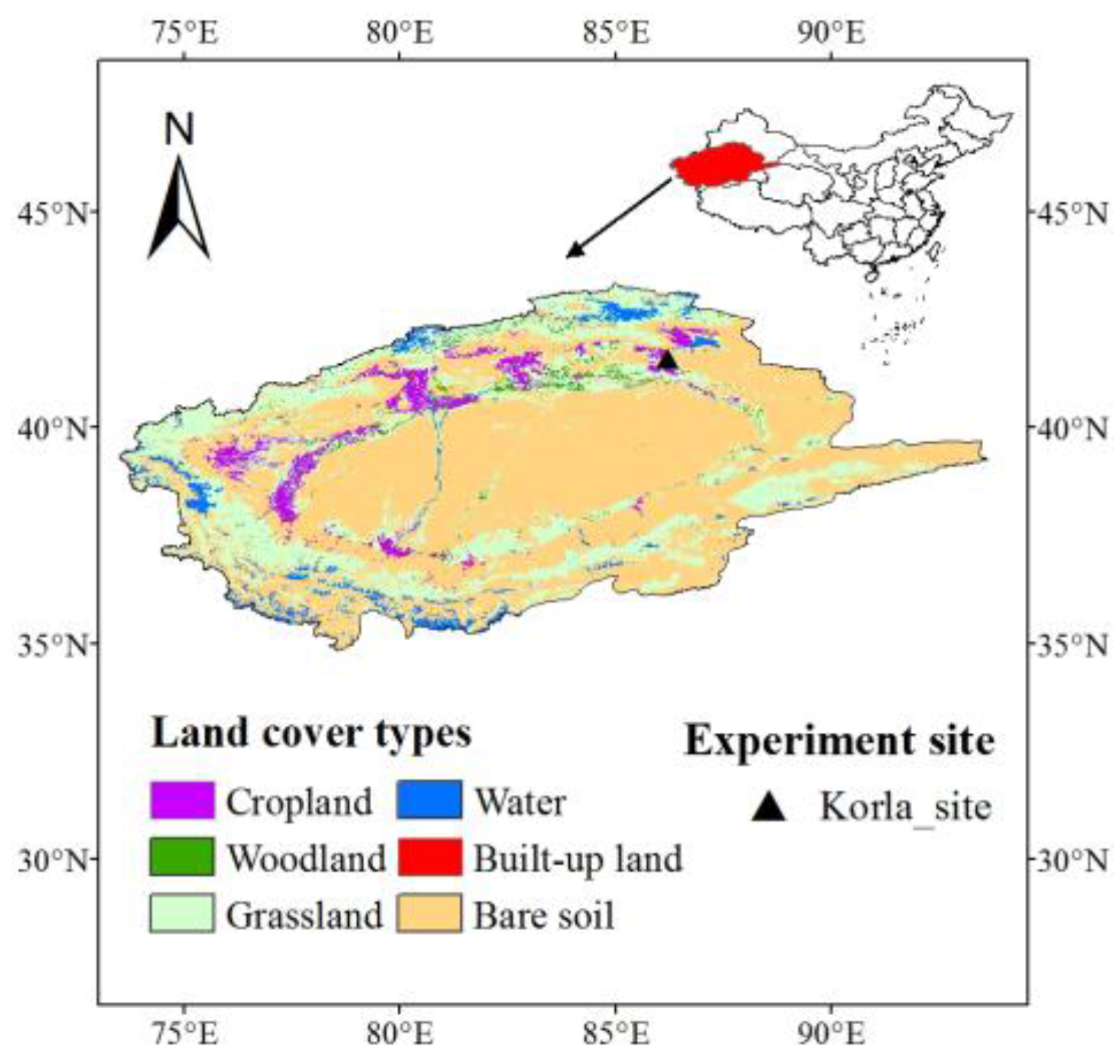


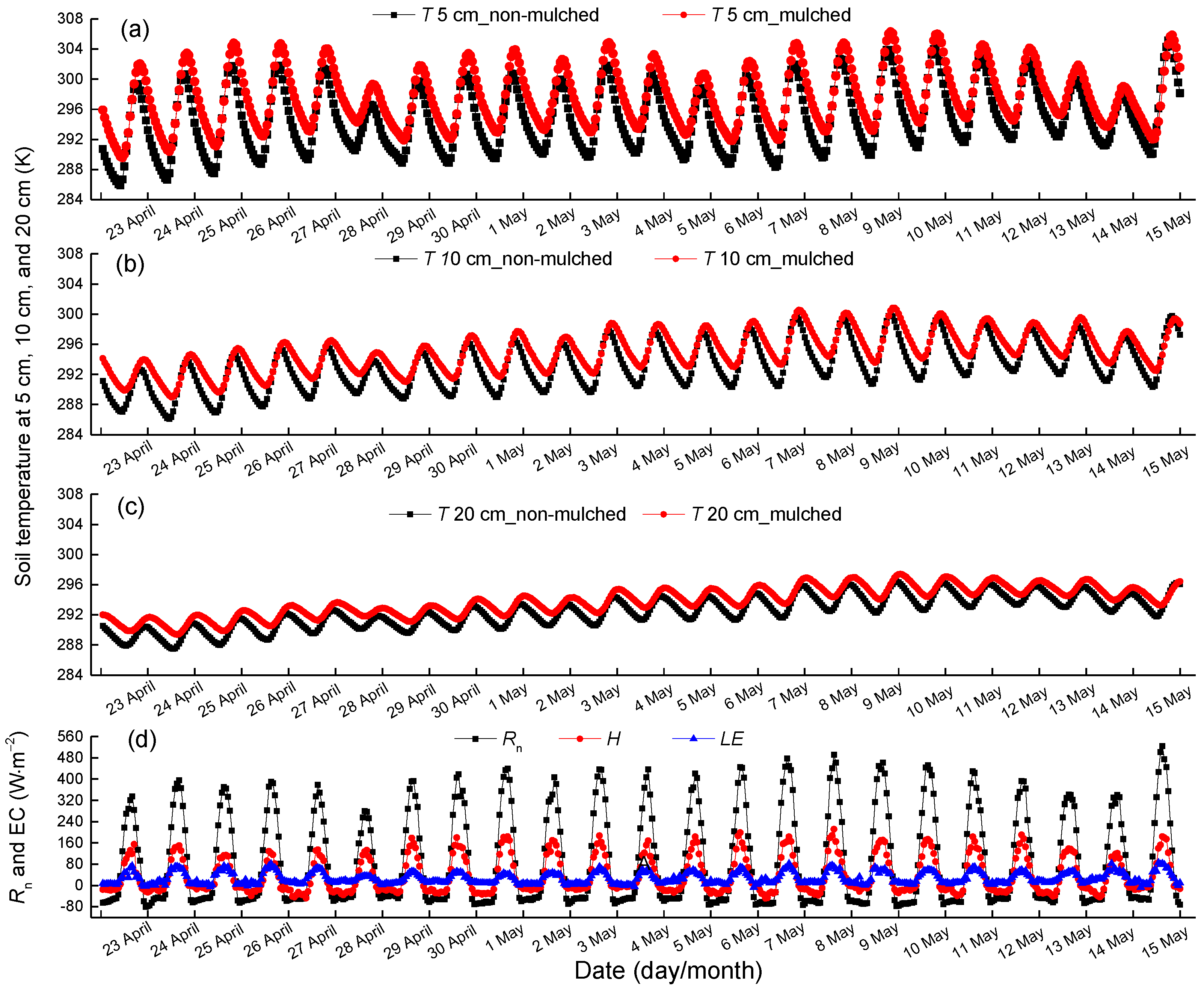


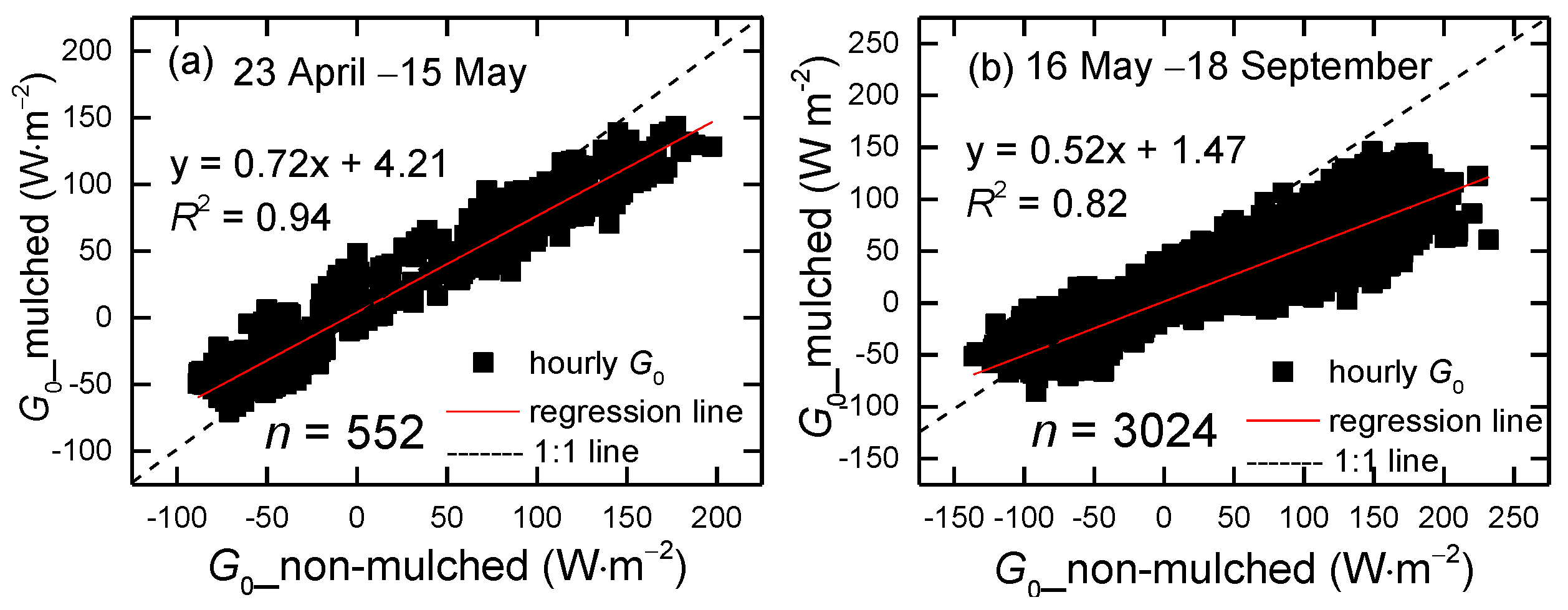
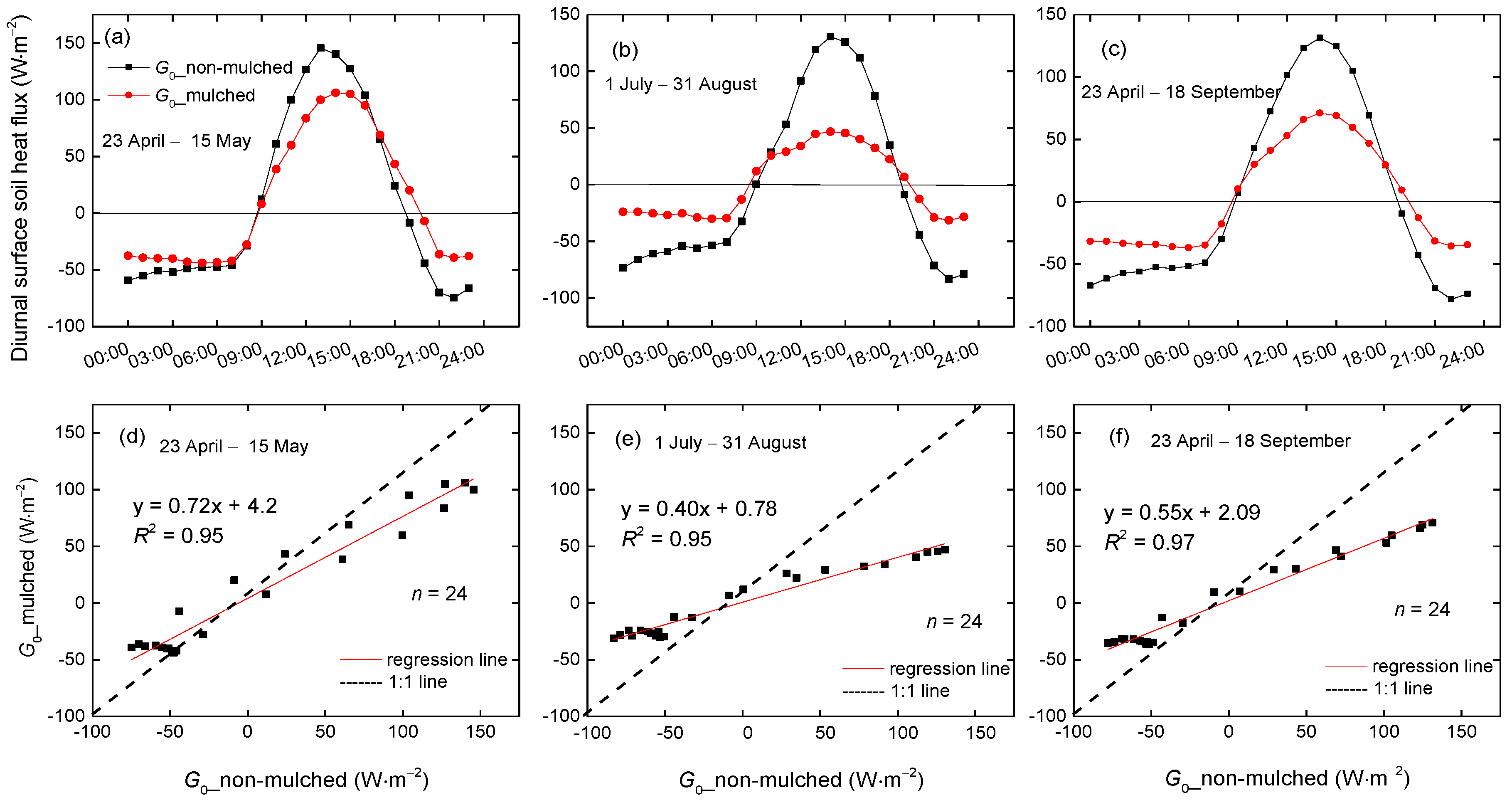
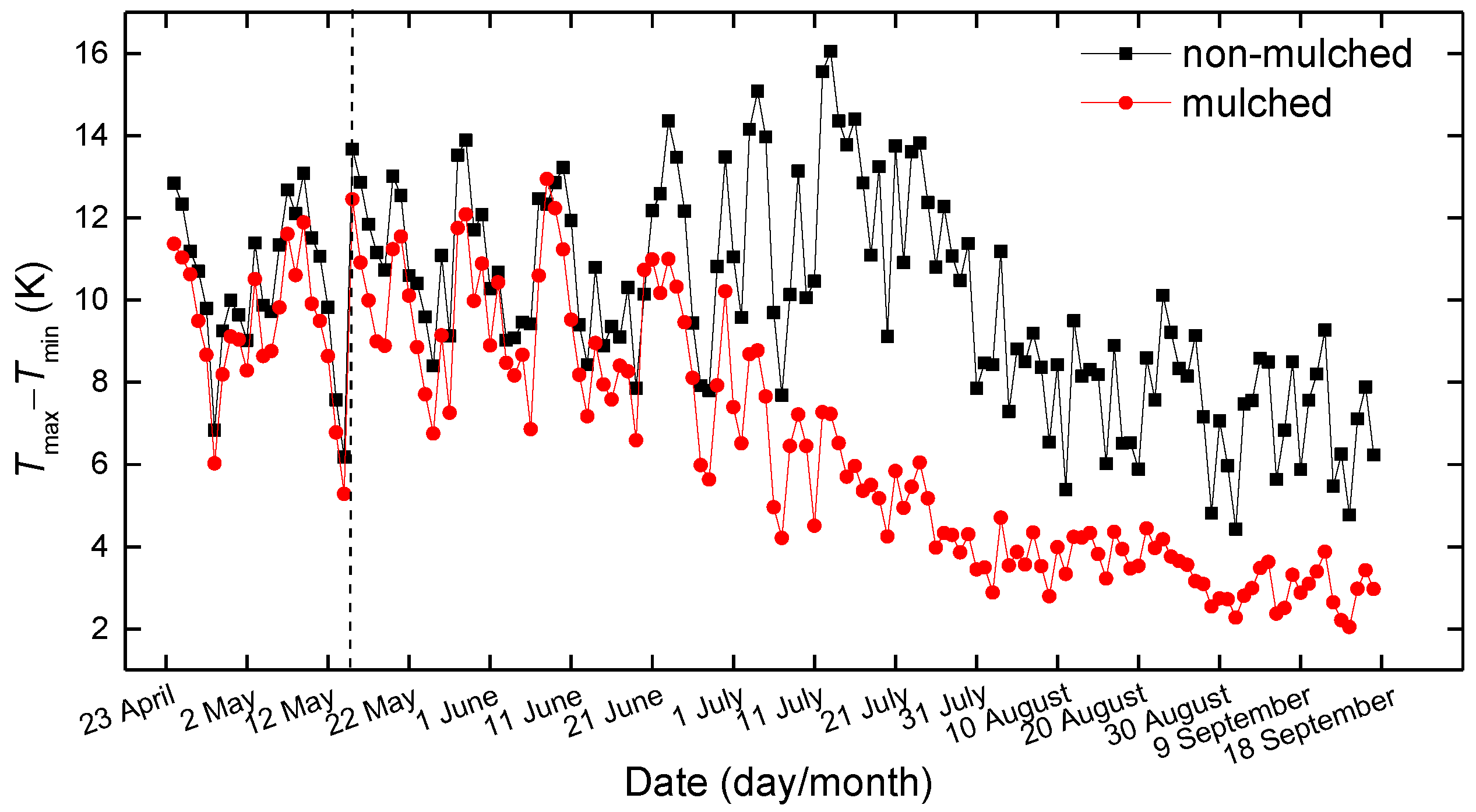

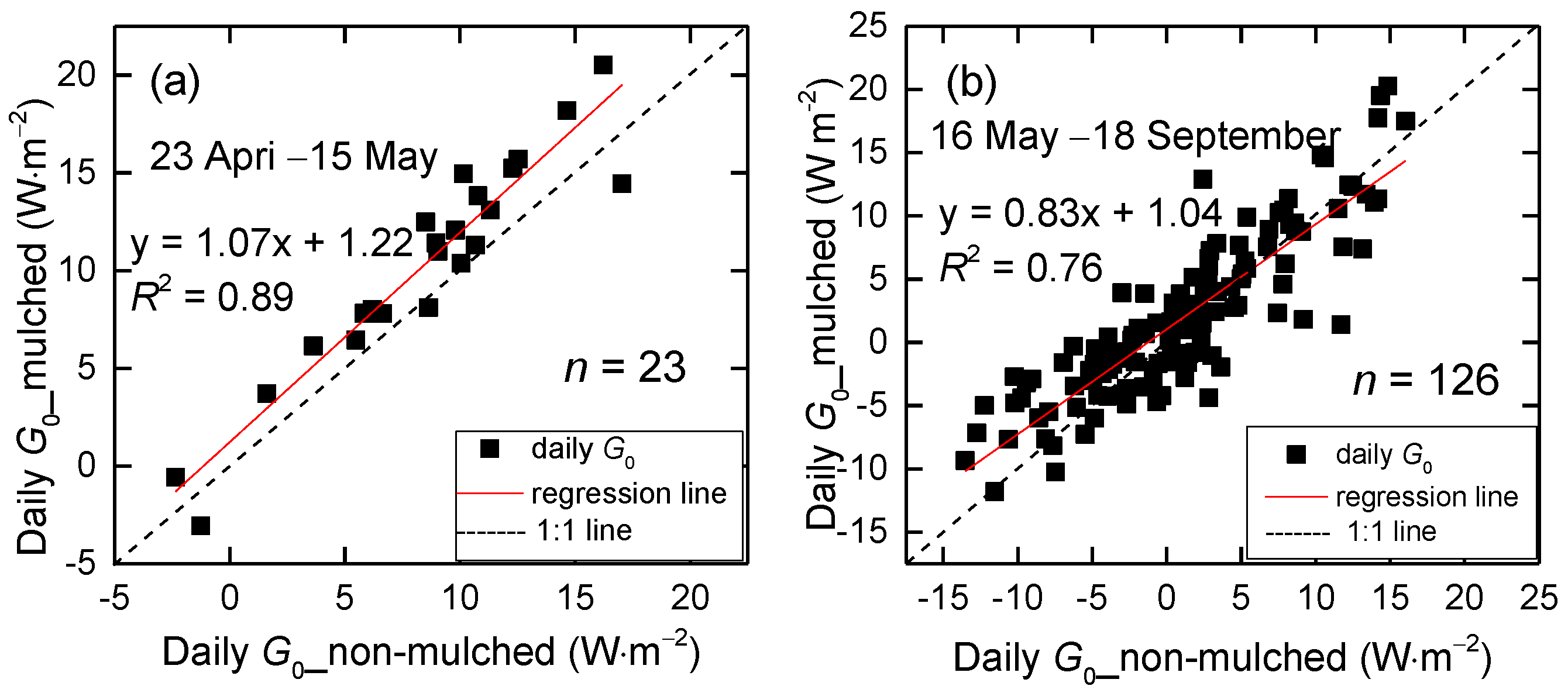

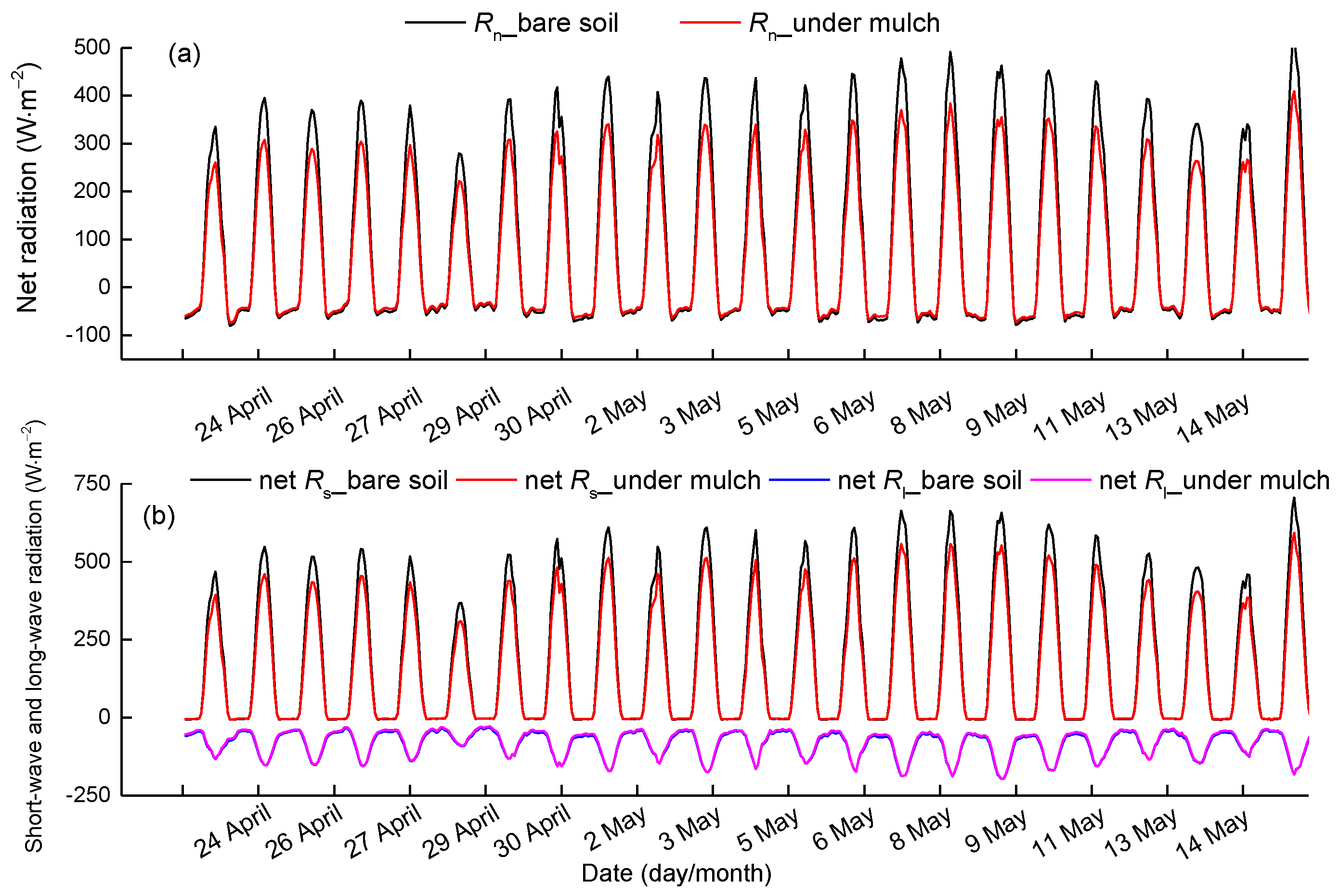

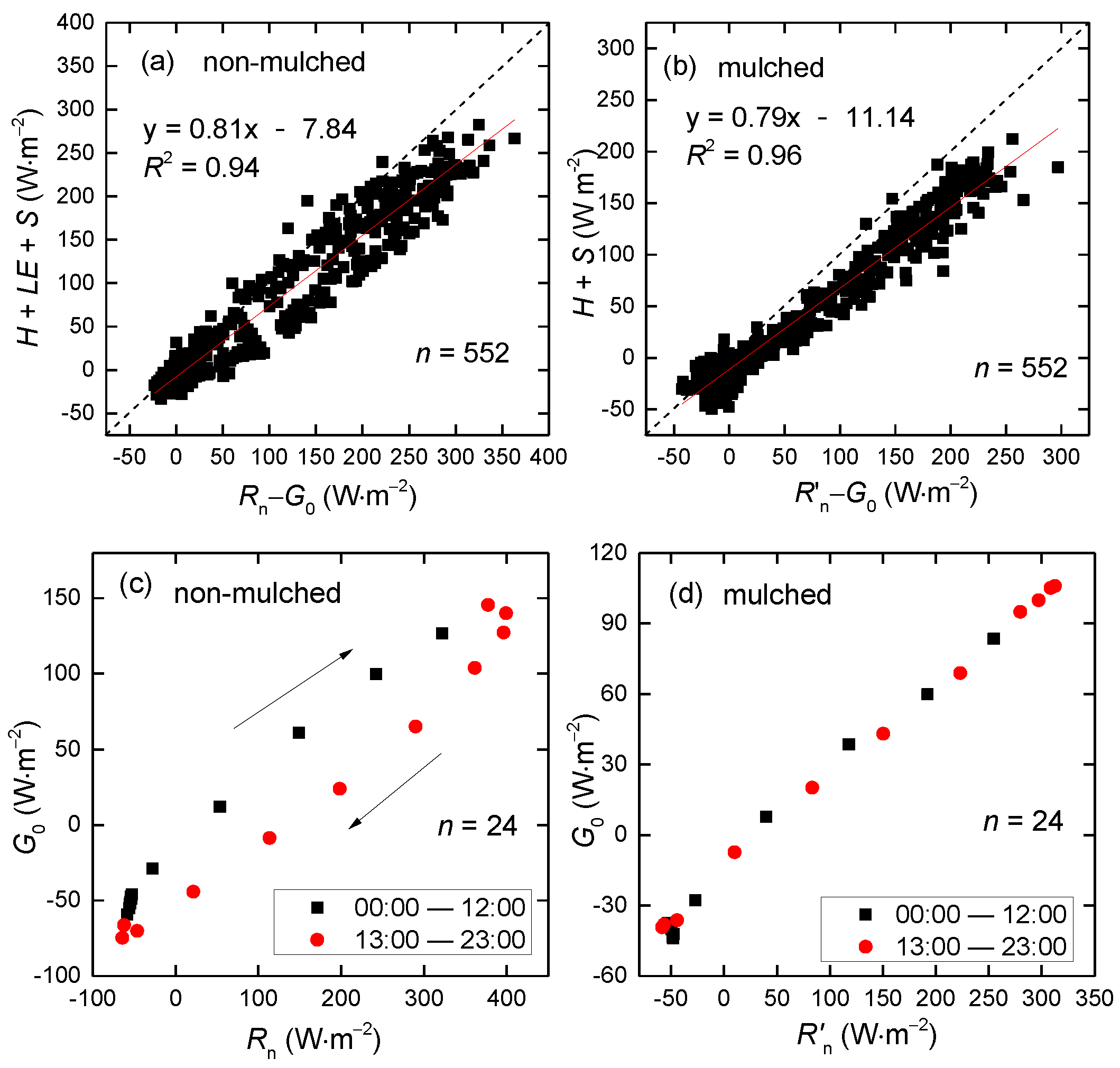
| Instrument | Parameters | 2013 (m) | 2014 (m) | 2015 (m) |
|---|---|---|---|---|
| Eddy covariance system (EC) | Latent heat flux and sensible heat flux | 2.25 | 2.25 | 2.25 |
| Atmospheric moisture density | 2.25 | 2.25 | 2.25 | |
| Automatic weather station (AWS) | Soil temperature | 0.05, 0.1, 0.2, 0.3, 0.4, 0.5, 0.6, 0.8 | 0.1, 0.2, 0.3, 0.5, 0.6 | 0.05, 0.1, 0.2, 0.3, 0.4, 0.6, 0.8, 1.0, 1.2 |
| Soil water content | 0.05, 0.1, 0.2, 0.3, 0.4, 0.5, 0.6, 0.8 | 0.1, 0.2, 0.3, 0.5, 0.6 | 0.05, 0.1, 0.2, 0.3, 0.4, 0.6, 0.8, 1.0, 1.2 | |
| Net radiation | 2.25 | 2.25 | 2.25 | |
| Air temperature | 2.8 | 2.8 | 2.8 |
| Non-mulched | Beneath Mulch | Non-mulched | Beneath Mulch | |
|---|---|---|---|---|
| 23 April–15 May (W·m–2) | 16 May–18 September (W·m–2) | |||
| Sum of positive | 200.0 | 242.5 | 409.0 | 446.5 |
| Sum of negative | −3.6 | −3.6 | −281.7 | −202.5 |
| Sum | 196.4 | 238.8 | 127.4 | 244.0 |
© 2016 by the authors; licensee MDPI, Basel, Switzerland. This article is an open access article distributed under the terms and conditions of the Creative Commons Attribution (CC-BY) license (http://creativecommons.org/licenses/by/4.0/).
Share and Cite
Li, N.; Tian, F.; Hu, H.; Lu, H.; Ming, G. Effects of Plastic Mulch on Soil Heat Flux and Energy Balance in a Cotton Field in Northwest China. Atmosphere 2016, 7, 107. https://doi.org/10.3390/atmos7080107
Li N, Tian F, Hu H, Lu H, Ming G. Effects of Plastic Mulch on Soil Heat Flux and Energy Balance in a Cotton Field in Northwest China. Atmosphere. 2016; 7(8):107. https://doi.org/10.3390/atmos7080107
Chicago/Turabian StyleLi, Nana, Fuqiang Tian, Hongchang Hu, Hui Lu, and Guanghui Ming. 2016. "Effects of Plastic Mulch on Soil Heat Flux and Energy Balance in a Cotton Field in Northwest China" Atmosphere 7, no. 8: 107. https://doi.org/10.3390/atmos7080107
APA StyleLi, N., Tian, F., Hu, H., Lu, H., & Ming, G. (2016). Effects of Plastic Mulch on Soil Heat Flux and Energy Balance in a Cotton Field in Northwest China. Atmosphere, 7(8), 107. https://doi.org/10.3390/atmos7080107







